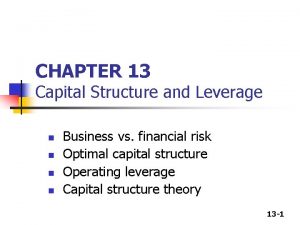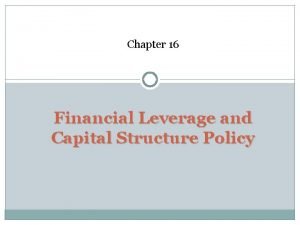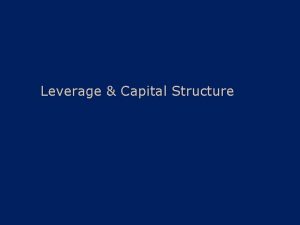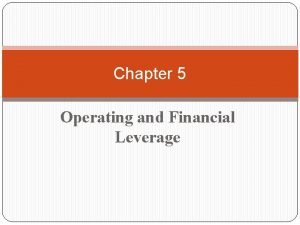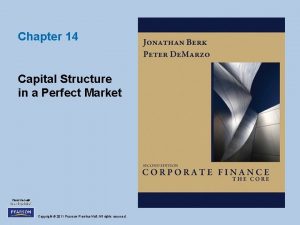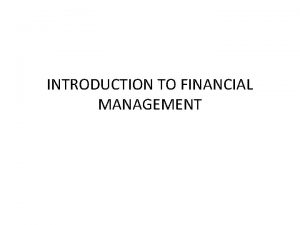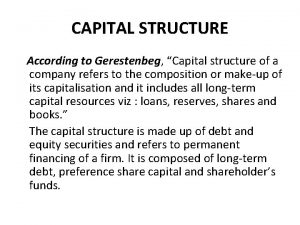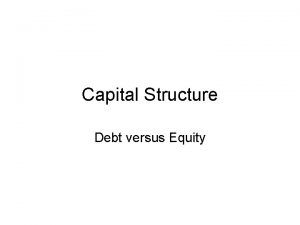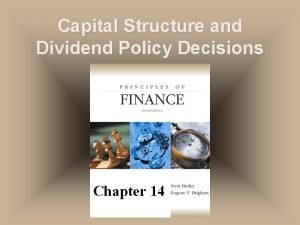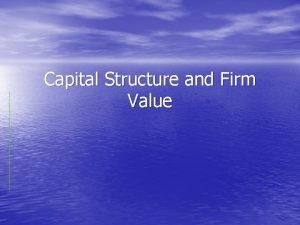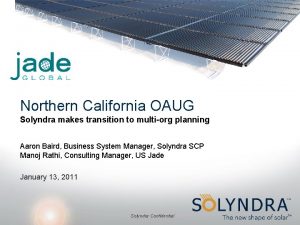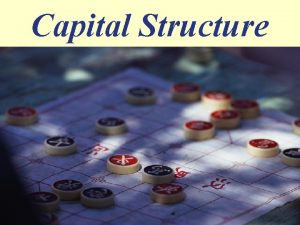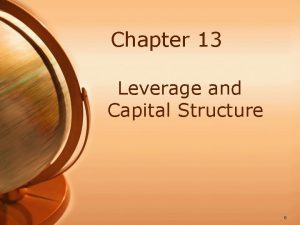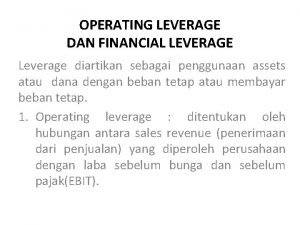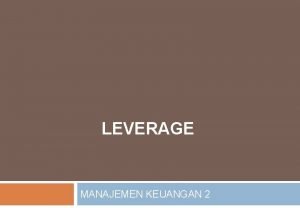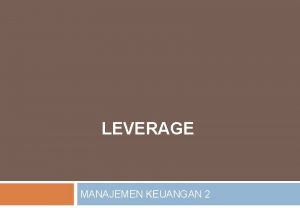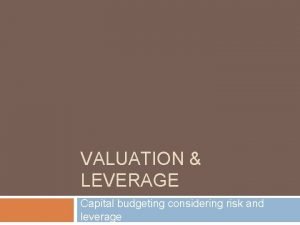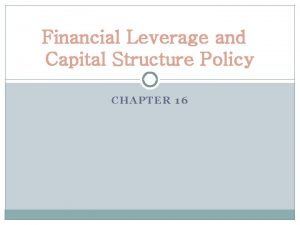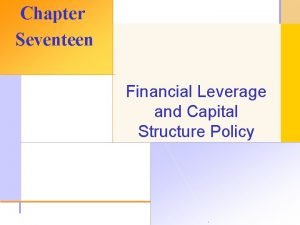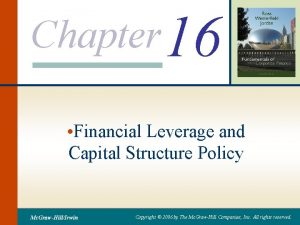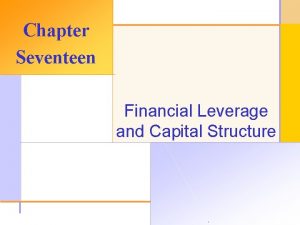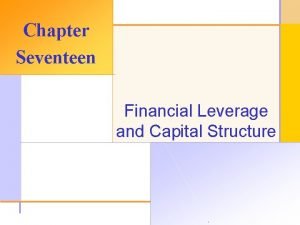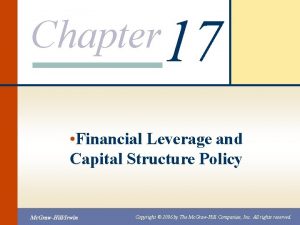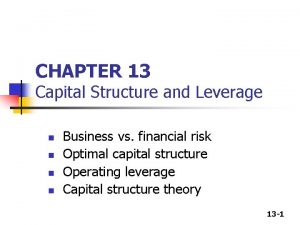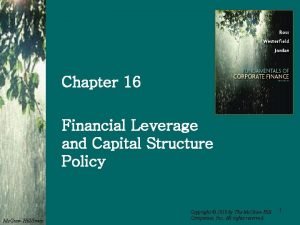Chapter 7 Leverage and Capital Structure Leverage Leverage





















- Slides: 21

Chapter 7 Leverage and Capital Structure

Leverage • Leverage results from the use of fixed-cost assets or funds to magnify returns to the firm’s owners. • Generally, increases in leverage result in increases in risk and return, whereas decreases in leverage result in decreases in risk and return. • The amount of leverage in the firm’s capital structure— the mix of debt and equity—can significantly affect its value by affecting risk and return. Copyright © 2006 Pearson Addison-Wesley. All rights reserved. 11 -2

3 basis types of leverage • Operating leverage-concerned with the relationship between the firm’s sales revenue and its earnings before interest and taxes. • Financial Leverage-concerned with the relationship between the firm’s EBIT and its earnings per share • Total leverage-concerned with the relationship between the firm’s sales revenue and EPS. Copyright © 2006 Pearson Addison-Wesley. All rights reserved. 11 -3

Leverage (cont. ) Copyright © 2006 Pearson Addison-Wesley. All rights reserved. 11 -4

Breakeven Analysis • Breakeven (cost-volume-profit) analysis is used by the firm to: – determine the level of operations necessary to cover all operating costs, and – evaluate the profitability associated with various levels of sales. • The firm’s operating breakeven point (OBP) is the level of sales necessary to cover all operating expenses. • At the OBP, operating profit (EBIT) is equal to zero. Copyright © 2006 Pearson Addison-Wesley. All rights reserved. 11 -5

Breakeven Analysis (cont. ) • To calculate the OBP, cost of goods sold and operating expenses must be categorized as fixed or variable. • Variable costs vary directly with the level of sales and are a function of volume, not time. • Examples would include direct labor and shipping costs. • Fixed costs are a function of time and do not vary with sales volume. • Examples would include rent and fixed overhead. Copyright © 2006 Pearson Addison-Wesley. All rights reserved. 11 -6

• Breakeven quantity= FC P-VC Copyright © 2006 Pearson Addison-Wesley. All rights reserved. 11 -7

Kumaran’s posters( a small poster retailer) has fixed operating cost of 250 OR, its sales price per unit is 10 OR and its variable operating cost per unit is 5 OR. Calculate the break even units. Copyright © 2006 Pearson Addison-Wesley. All rights reserved. 11 -8

OPERATING LEVERAGE Operating leverage results from the existence of fixed operating costs in the firm’s income stream. Operating leverage can be defined as the potential use of fixed operating costs to magnify the effects of changes in sales on the firm’s earnings before interest and taxes. Copyright © 2006 Pearson Addison-Wesley. All rights reserved. 11 -9

Operating Leverage (cont. ) Copyright © 2006 Pearson Addison-Wesley. All rights reserved. 11 -10

Operating Leverage: Measuring the Degree of Operating Leverage • The degree of operating leverage (DOL) measures the sensitivity of changes in EBIT to changes in Sales. • A company’s DOL can be calculated in two different ways: One calculation will give you a point estimate, the other will yield an interval estimate of DOL. • Only companies that use fixed costs in the production process will experience operating leverage. Copyright © 2006 Pearson Addison-Wesley. All rights reserved. 11 -11

Operating Leverage: Measuring the Degree of Operating Leverage (cont) DOL = Percentage change in EBIT Percentage change in Sales • Applying this equation to cases 1 and 2 in Table 12. 4 yields: Case 1: DOL = (+100% ÷ +50%) = 2. 0 Case 2: DOL = (-100% ÷ -50%) = 2. 0 Copyright © 2006 Pearson Addison-Wesley. All rights reserved. 11 -12

Financial Leverage • Financial leverage results from the presence of fixed financial costs in the firm’s income stream. • Financial leverage can therefore be defined as the potential use of fixed financial costs to magnify the effects of changes in EBIT on the firm’s EPS. • The two fixed financial costs most commonly found on the firm’s income statement are (1) interest on debt and (2) preferred stock dividends. Copyright © 2006 Pearson Addison-Wesley. All rights reserved. 11 -13

Financial Leverage (cont. ) Chen Foods, a small Oriental food company, expects EBIT of $10, 000 in the current year. It has a $20, 000 bond with a 10% annual coupon rate and an issue of 600 shares of $4 annual dividend preferred stock. It also has 1, 000 share of common stock outstanding. The annual interest on the bond issue is $2, 000 (10% x $20, 000). The annual dividends on the preferred stock are $2, 400 ($4/share x 600 shares). Copyright © 2006 Pearson Addison-Wesley. All rights reserved. 11 -14

Financial Leverage (cont. ) Copyright © 2006 Pearson Addison-Wesley. All rights reserved. 11 -15

Financial Leverage: Measuring the Degree of Financial Leverage • The degree of financial leverage (DFL) measures the sensitivity of changes in EPS to changes in EBIT. • Like the DOL, DFL can be calculated in two different ways: One calculation will give you a point estimate, the other will yield an interval estimate of DFL. • Only companies that use debt or other forms of fixed cost financing (like preferred stock) will experience financial leverage. Copyright © 2006 Pearson Addison-Wesley. All rights reserved. 11 -16

Financial Leverage: Measuring the Degree of Financial Leverage (cont) DFL = Percentage change in EPS Percentage change in EBIT • Applying this equation to cases 1 and 2 in Table 12. 6 yields: Case 1: DFL = (+100% ÷ +40%) = 2. 5 Case 2: DFL = (-100% ÷ -40%) = 2. 5 Copyright © 2006 Pearson Addison-Wesley. All rights reserved. 11 -17

Total Leverage • Total leverage results from the combined effect of using fixed costs, both operating and financial, to magnify the effect of changes in sales on the firm’s earnings per share. • Total leverage can therefore be viewed as the total impact of the fixed costs in the firm’s operating and financial structure. Copyright © 2006 Pearson Addison-Wesley. All rights reserved. 11 -18

Total Leverage (cont. ) Cables Inc. , a computer cable manufacturer, expects sales of 20, 000 units at $5 per unit in the coming year and must meet the following obligations: variable operating costs of $2 per unit, fixed operating costs of $10, 000, interest of $20, 000, and preferred stock dividends of $12, 000. The firm is in the 40% tax bracket and has 5, 000 shares of common stock outstanding. Table 12. 7 on the following slide summarizes these figures. Copyright © 2006 Pearson Addison-Wesley. All rights reserved. 11 -19

Total Leverage (cont. ) Copyright © 2006 Pearson Addison-Wesley. All rights reserved. 11 -20

Total Leverage: The Relationship of Operating, Financial and Total Leverage The relationship between the DTL, DOL, and DFL is illustrated in the following equation: DTL = DOL x DFL Copyright © 2006 Pearson Addison-Wesley. All rights reserved. 11 -21
 Chapter 13 leverage and capital structure gitman ppt
Chapter 13 leverage and capital structure gitman ppt Financial leverage and capital structure policy
Financial leverage and capital structure policy Capital structure leverage
Capital structure leverage The degree of operating leverage formula
The degree of operating leverage formula Multinational cost of capital and capital structure
Multinational cost of capital and capital structure Multinational cost of capital and capital structure
Multinational cost of capital and capital structure Net working capital refers to which of the following
Net working capital refers to which of the following Difference between capital reserve and reserve capital
Difference between capital reserve and reserve capital Difference between capital reserve and reserve capital
Difference between capital reserve and reserve capital Constant capital and variable capital
Constant capital and variable capital Operating and financial leverage chapter 5
Operating and financial leverage chapter 5 Capital structure in a perfect market
Capital structure in a perfect market Basle ii
Basle ii Regulatory capital vs economic capital
Regulatory capital vs economic capital Capital allocation line vs capital market line
Capital allocation line vs capital market line Difference between capital structure and capitalisation
Difference between capital structure and capitalisation Types of capital structure
Types of capital structure Advantages of debt
Advantages of debt Dividend policy and capital structure
Dividend policy and capital structure Capital structure and firm value
Capital structure and firm value Business risk and financial risk leverage
Business risk and financial risk leverage Lift and leverage
Lift and leverage
